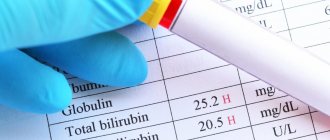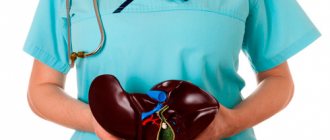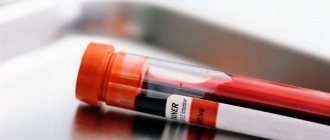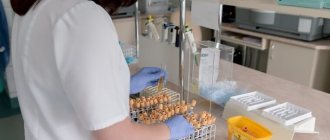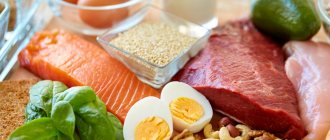Hyperbilirubinemia (HBN) is not an independent disease, but a laboratory syndrome that occurs in many nosological forms. Bilirubin is a yellow pigment that is formed from hemoglobin in red blood cells that have been destroyed by the reticuloendothelial system (splenic sinusoids). It is then metabolized by the liver and excreted in bile. Its increase confirms the presence of true jaundice in the patient. Determining the concentration of bilirubin fractions (unconjugated, conjugated) helps in establishing the origin of jaundice (prehepatic, hepatic, subhepatic).
Causes of hyperbilirubinemia
Hyperbilirubinemia almost always indicates pathology. However, there are exceptions. For example, the cause of hyperbilirubinemia can be prolonged fasting (deficiency of albumin, cellular carrier proteins), the use of drugs that cause competitive inhibition of the uptake of bilirubin by hepatocytes (radiocontrast agents, drugs for the treatment of helminthiases).
In newborns, the cause of hyperbilirubinemia is physiological jaundice, which develops due to the immaturity of the enzyme systems of bilirubin metabolism. The causes of pathological hyperbilirubinemia are as follows (listed in order of frequency):
- Liver diseases
. The most common cause of hyperbilirubinemia. The destruction of hepatocyte membranes leads to the release of bilirubin and its entry into the bloodstream. This occurs with any infectious liver lesions (viral, bacterial, protozoal hepatitis), alcoholic, autoimmune hepatitis, cirrhosis. - Diseases of the biliary tract
. The second most common cause of hyperbilirubinemia. As a result of intrahepatic and extrahepatic cholestasis, which is observed with cholecystitis, cholelithiasis, cholangitis, the permeability of bile capillaries increases. Under the influence of high hydrostatic pressure, bilirubin diffuses into the blood vessels. - Hemolytic anemia (HA)
. With increased destruction of red blood cells (hemolysis), the amount of free bilirubin in the blood increases. This is typical for both congenital (hereditary microspherocytosis, sickle cell anemia, thalassemia) and acquired hemolytic anemia (paroxysmal nocturnal hemoglobinuria, autoimmune, drug-induced HA). - Hereditary enzymopathies
. Genetically determined defects in the enzymes of hepatic metabolism of bilirubin lead to disruption of its uptake by hepatocytes, conjugation with glucuronic acid, or secretion into bile. This group of diseases is called benign hyperbilirubinemia (Gilbert, Crigler-Nayar, Dabin-Jones syndrome). - Metabolic disorders
. These are rare hereditary diseases that affect the liver parenchyma, in which bound bilirubin enters the blood. These include hemochromatosis, Wilson-Konovalov disease, lysosomal storage diseases (Gaucher disease, Niemann-Pick disease). - Pathology of the upper gastrointestinal tract
. Some diseases of the digestive system (pseudotumorous pancreatitis, pancreatic tumor, stenosis of the major duodenal papilla) can create a mechanical obstacle to the outflow of bile due to compression of the bile ducts, thereby leading to their overflow, diffusion of bile pigment into the capillaries.
Treatment of Gilbert's syndrome
The mere presence of Gilbert's syndrome in children and adults is not an indication for drug treatment.
To prevent exacerbation of the disease and the development of complications, general measures are important: limiting participation in strenuous sports, prolonged exposure to the sun, consumption of alcoholic beverages and hepatotoxic drugs. Such patients need to eat right, avoid prolonged fasting, as well as foods containing indigestible fats - fatty meats, fried and spicy foods, canned foods. During an exacerbation of the clinical manifestations of the disease, plenty of fluids and a gentle diet corresponding to table No. 5 are prescribed. Conservative therapy during this period is aimed at reducing the formation and accelerating the removal from the body of excess amounts of unconjugated hemoglobin and includes:
- taking microsomal enzyme inducers (phenobarbital, zixorine);
- taking activated carbon;
- phototherapy.
For the prevention of cholecystitis and cholelithiasis in Gilbert's syndrome, the use of choleretic herbs, hepatoprotectors (ursosan, ursofalk), essential phospholipids, choleretics (cholagol, allochol, holosas) and B vitamins is recommended.
Pathogenesis
Features of the pathogenesis (mechanisms of occurrence) of hyperbilirubinemia are determined by the cause. Free (indirect, unconjugated) bilirubin is poorly soluble in water, but has high lipophilicity, i.e. soluble in fats. Therefore, it can interact with phospholipids of cell membranes, especially brain cells, due to which it penetrates the blood-brain barrier, where it uncouples the processes of oxidative phosphorylation and reduces ATP synthesis.
This explains the toxicity of free bilirubin to cells of the nervous system. This is most pronounced in newborns. Bilirubin can color the skin, visible mucous membranes, urine, and feces a characteristic yellow or dark brown color. With prolonged cholestasis, which causes an increase in the concentration of conjugated bilirubin, catabolism and cholesterol excretion may be impaired, which leads to its accumulation in the blood and the progression of atherosclerosis.
Classification
Depending on which fraction of bile pigment is increased, there are:
- Indirect hyperbilirubinemia
. Unconjugated (unbound) bilirubin is increased. The cause is pathologies that cause suprahepatic jaundice - hemolytic anemia, benign hyperbilirubinemia. - Direct hyperbilirubinemia
. Accompanied by an increase in the level of conjugated (bound) bilirubin. The cause is diseases leading to hepatocellular and subhepatic jaundice. The most common of them are viral, alcoholic hepatitis, cholecystitis.
Bilirubin encephalopathy (kernicterus) is distinguished separately. It occurs in hemolytic disease of newborns, the cause of which is the incompatibility of erythrocyte antigens (Rh conflict) of the mother and fetus. This disease is very serious, it is characterized by damage to the subcortical nuclei and cerebral cortex and requires immediate treatment.
Symptoms of hyperbilirubinemia
The accumulation of yellow pigment in the skin, mucous membranes, and biological fluids leads to a change in their color, which is the main symptom of hyperbilirubinemia. Yellowness of the sclera is the earliest sign; it occurs when the concentration of bilirubin exceeds normal levels by 2 times. The palate and back of the tongue also begin to stain early. The skin becomes yellow at levels above 80-85 µmol/l.
With different diseases, there is an unequal intensity of skin coloration and different shades. For example, with hemolytic anemia, the skin and mucous membranes have a faint lemon-yellow color, and the stool becomes dark. With liver diseases, the skin becomes orange-yellow and the urine becomes dark in color. With pathology of the biliary tract, bilirubin accumulating in the skin is oxidized to biliverdin, which gives it a bright green-yellow color, and feces, on the contrary, due to a violation of the outflow of bile, become light (“acholic feces”). In cases of prolonged cholestasis, bilirubin in the skin begins to increase pigmentation, causing it to become dark.
Other symptoms depend on the cause of hyperbilirubinemia. Patients with hemolytic anemia experience fever (due to the pyrogenic activity of free bilirubin), enlarged spleen, anemic syndrome - pale skin, increased heart rate, decreased blood pressure. With liver diseases and gallbladder, patients are often bothered by heaviness or dull pain in the right hypochondrium, attacks of biliary colic, and unbearable skin itching.
In patients with benign hyperbilirubinemia, the clinical picture is dominated by asthenovegetative syndrome (general weakness, drowsiness, deterioration in concentration). In adults, unlike newborns, despite the high concentration of bile pigment, encephalopathy does not develop.
Increased indirect bilirubin - reasons
The amount of indirect bilirubin in the blood increases when too many red blood cells are destroyed. This occurs in the following pathologies:
- Hemolytic anemia: congenital, acquired autoimmune (against the background of systemic lupus erythematosus, rheumatoid arthritis, lymphocytic leukemia, etc.), toxic (poisoning with drugs, poisons, mushrooms, insect bites, etc.);
- Infectious diseases: sepsis, typhoid fever, malaria;
- Gilbert, Crigler-Najjar, Lucy-Driscoll syndromes.
Pain in the right side: what could it be? How to recognize the disease by one symptom? We are studying which organs can cause pain in the right hypochondrium.
Complications
The most common and dangerous complications are associated not with hyperbilirubinemia itself, but with the cause that caused it. Severe adverse consequences of hyperbilirubinemia occur in newborns with kernicterus. Deep damage to the subcortical nuclei and cerebral cortex without timely treatment can lead to sensorineural hearing loss, seizures, and in some cases, death. Due to the deterioration of cholesterol excretion into bile, its plasma concentration increases, as a result of which the process of formation of atherosclerotic plaque is accelerated. This increases the risk of myocardial infarction and ischemic stroke.
Consequences of high bilirubin
We know from the school biology and chemistry course that bilirubin is the main pigment of bile and a constant component of blood, which is formed as a result of the breakdown of blood proteins (mainly hemoglobin, but also myoglobin, cytochromes and some protein enzymes).
However, few people know that bilirubin is not just a substance that turns urine yellow, but also a strong tissue poison. And if bilirubin in the blood is elevated, or rather its level in the blood exceeds the permissible norm, this is a reason to consult a specialist. The situation is especially serious when high bilirubin is observed in newborns - the little person’s body is in the initial stages of formation, and every cell is important for it. It is high levels of bilirubin that cause jaundice in newborns, which primarily affects the brain and liver cells.
In the blood, bilirubin is found in two states: bound to proteins (albumin) - direct bilirubin, and free - indirect. Laboratory testing determines total and direct bilirubin. It is dangerous if total bilirubin is elevated - this means that there is a high level of free bilirubin in the blood, which is an extremely toxic substance that easily penetrates cells and destroys them. It is insoluble in water, so it cannot be excreted in the urine like direct bilirubin.
A high level of bilirubin in a child is:
- Negative effects of the toxin on the cells of the liver and other internal organs;
- Negative effect on the brain;
- Problems in the development of the brain and organs;
- In the future - problems with the general development of the child and the development of organs and systems.
Therefore, high total bilirubin in infants is an indicator that should never be ignored. It is worth remembering how much bilirubin is normal for a one-month-old baby:
- Direct – 0.7-5.2 µmol/l;
- Indirect – 1.7-17 µmol/l;
- General – 3.4 – 20.5 µmol/l.
If these indicators are exceeded, experts recommend starting treatment for jaundice, however, in each case, the severity and severity of the disease are different, since bilirubin in infants is often a rather unstable value. For example, the dynamics of its concentration in the first ten days after birth ranges from 22 µmol/l at birth to 120 µmol/l on the 9-10th day, and in the absence of external manifestations of jaundice, these indicators are conventionally considered the norm. But it also happens that already at 40 µmol/l in the first days of life, the child has pronounced jaundice of the skin and sclera.
The main and most effective way to prevent an increase in bilirubin in the blood is a phototherapy lamp. Phototherapy as a method of treating jaundice and a number of other diseases has long proven to be highly effective. For example, jaundice in newborns can be cured within 3-5 days using phototherapy.
And the most important thing is that if bilirubin is elevated, you should not think that “it will go away on its own” and procrastinate. The sooner you start treating your newborn, the fewer negative consequences there will be and the faster the recovery will come. Do not risk your child’s health, start treatment immediately after identifying the first symptoms!
Diagnostics
The profile of the specialist who supervises a patient with hyperbilirubinemia is determined by the cause that caused it. Most often, such patients are treated by gastroenterologists and hematologists. When examining the patient, the skin, mucous membranes of the eyes, mouth are carefully examined, the abdomen is palpated for hepatosplenomegaly, symptoms of bile duct damage (Murphy, Ortner, Kera). To determine the cause of hyperbilirubinemia, additional examination is prescribed, including:
- Laboratory research
. In a general blood test, the level of red blood cells and hemoglobin is assessed, and the morphology of red blood cells is studied in a blood smear. In blood biochemistry, the values of bilirubin fractions, liver transaminases, alkaline phosphatase, and gamma-glutamyl transpeptidase are determined. Iron metabolism indicators (ferritin, transferrin) are checked. A urine test measures the concentration of urobilin and bilirubin. Using ELISA, antibodies to antigens of hepatitis viruses A, B, C, and autoimmune antibodies (ANCA, AMA) are detected. - Instrumental Research
. Ultrasound of the abdominal organs reveals enlargement, diffuse changes in the liver parenchyma, the presence of stones, and thickening of the walls of the gallbladder. In hemolytic anemia, splenomegaly is significantly expressed. In some pathologies of the bile ducts and pancreas, retrograde cholangiopancreatography reveals areas of stenosis and dilation of the ducts. - Provocative tests
. To diagnose benign hyperbilirubinemia caused by genetic defects in the enzymes of bilirubin metabolism, special tests are performed (test with 48-hour fasting, intravenous administration of a solution of nicotinic acid, bromsulfalein). If the bilirubin level increases by more than 50%, the test is considered positive.
The differential diagnosis of hyperbilirubinemia can be made by its main clinical manifestation – jaundice. Jaundice discoloration of the skin is possible when eating a large amount of foods rich in carotene (carrots, pumpkin, avocado), or taking certain medications (akrikhina). The main distinguishing feature of “pseudojaundice” from true jaundice is that the sclera remains unstained.
Treatment of hyperbilirubinemia
Conservative therapy
To normalize bile pigment levels, it is necessary to combat the cause of hyperbilirubinemia. Depending on the patient’s condition, he can undergo treatment either on an outpatient basis or in a hospital setting. Most often, such patients are hospitalized in the gastroenterology department. The following treatment methods are used:
- Diet
. For liver and gall bladder disease of any etiology, table No. 5 according to Pevzner is prescribed, in which meals should be frequent, small portions. Be sure to exclude alcohol, fatty, fried foods, and smoked foods. You should avoid eating foods that cause spasms of the gallbladder (tomatoes, nuts). - Direct decrease in bilirubin in the blood
. Phototherapy with ultraviolet lamps is very effective for the treatment of tension-type headache. Under the influence of UV rays, free bilirubin accumulated in the skin becomes water-soluble, due to which it is quickly excreted from the body through the kidneys. If this treatment is ineffective, they resort to plasma or blood transfusion. Phenobarbital is used to reduce the concentration of indirect bilirubin in benign HDN. - Antiviral treatment
. To treat viral hepatitis, medications are used that suppress the activity of the hepatitis virus - peligated interferon-alpha, lamivudine, ribavirin. Triple therapy with entecavir is effective for the treatment of hepatitis C. - Treatment of cholestasis
. For many diseases accompanied by bile stasis, it is necessary to use medications that stimulate bile excretion. These are drugs containing bile acids (ursodeoxycholic acid, allochol, cholenzyme), herbal choleretic drugs (coriander, calendula, yarrow), FA sequestrants (cholestyramine). - Prevention of hemolysis
. For the treatment of hemolytic anemia, glucocorticosteroids, intravenous immunoglobulin, and hydroxyurea are used. To better stabilize red blood cell membranes, constant intake of folic acid is prescribed.
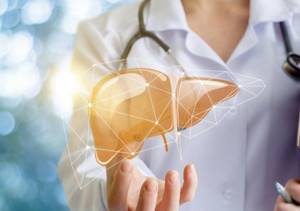
Surgery
The main method of treating cholelithiasis and calculous cholecystitis is surgical removal of the gallbladder (laparoscopic cholecystectomy). If conservative methods of treating hemolytic anemia fail, they resort to removal of the spleen (splenectomy). Tumors of the pancreas or duodenum that cause compression of the ducts also need to be surgically removed.
Increased total bilirubin - reasons
An increase in total bilirubin in adults leads to:
- Primary biliary cirrhosis;
- Gallstone disease and other conditions with impaired bile flow;
- Parasitic diseases;
- Liver tumors;
- Any type of hepatitis (viral, drug-induced, autoimmune, etc.);
- Intrahepatic cholestasis;
- Jaundice of pregnancy;
- Accelerated breakdown of red blood cells;
- Impaired production of enzymes in the liver that convert indirect bilirubin into direct bilirubin.
What the doctor sees on an ultrasound of the liver Ultrasound is the most popular diagnostic method when the patient complains of discomfort in the right side, nausea, weakness and general loss of strength.
Prognosis and prevention
The prognosis and life expectancy for hyperbilirubinemia is determined by the cause, i.e. main disease. For example, hemolytic disease of newborns, viral hepatitis B, C, and some forms of hemolytic anemia (hemoglobinopathies) are characterized by a high incidence of death. Benign hyperbilirubinemia and chronic cholecystitis, on the contrary, have a favorable prognosis and do not affect life expectancy in any way.
To prevent hyperbilirubinemia, you should limit the consumption of alcohol and fatty foods. For Rh-negative pregnant women, anti-Rhesus immunoglobulin (anti-D immunoglobulin) is administered to prevent the development of HDN.
